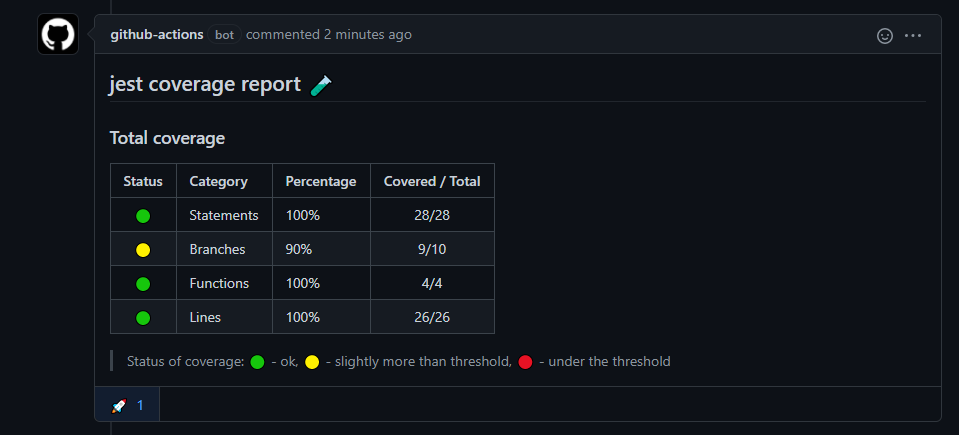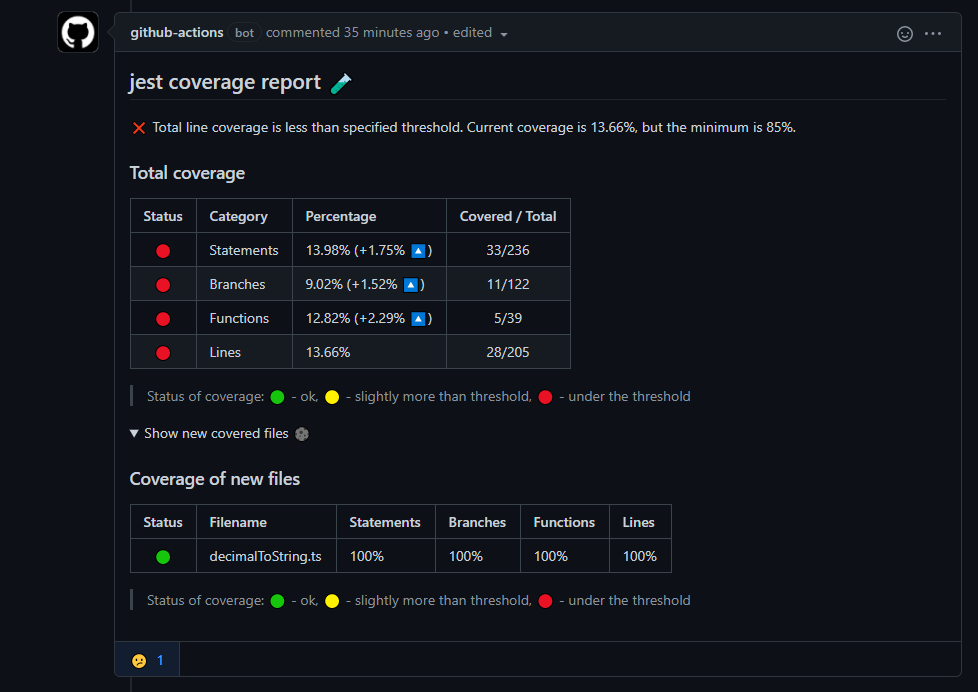jest coverage report 🧪
A GitHub action that reports about your code coverage in every pull request.
This action uses Jest to extract code coverage, and comments it on pull request. Inspired by Size-limit action. Features:
- Reporting code coverage on each pull request.
📃 - Rejecting pull request, if coverage is under threshold.
❌ - Comparing coverage with base branch. 🔍
- Showing spoiler in the comment for all new covered files.
🆕 - Showing spoiler in the comment for all files, in which coverage was reduced. 🔻
Usage
- Install and configure Jest.
- Create new action inside
.github/workflows:
Minimal configuration
name: 'coverage'
on:
pull_request:
branches:
- master
- main
jobs:
coverage:
runs-on: ubuntu-latest
if: "!contains(github.event.head_commit.message, '[skip ci]')"
steps:
- uses: actions/checkout@v1
- uses: artiomtr/jest-coverage-report-action@v2.0-rc.5
with:
github-token: ${{ secrets.GITHUB_TOKEN }}
# threshold: 80 # optional parameter- Pay attention to the action parameters. You can specify custom threshold or test script
- That's it!
Specify threshold
If you want to set minimal accepted coverage for the PR, you can pass and optional parameter threshold.
For example, if you want to reject every pull request, with total line coverage less than 80%:
with:
github-token: ${{ secrets.GITHUB_TOKEN }}
threshold: 80 # value in percentsCustom working directory
If you want to run this action in custom directory, specify working-directory:
with:
github-token: ${{ secrets.GITHUB_TOKEN }}
working-directory: <dir>Customizing test script
By default, this action will run this command, to extract coverage:
npx jest --silent --ci --coverage --coverageReporters="text" --coverageReporters="text-summary"If you're not satisfied with default behaviour, you can specify your own command, by passing custom option test-script.
⚠ IMPORTANT ⚠: Please, note that this is not simple
npx jest --coveragescript call. If you're specify your custom script, YOU SHOULD PASS SAME COVERAGE REPORTERS as it does default script (textandtext-summaryreporters). Without those options, your action will not work.
For instance, if you want to run test:coverage npm script:
with:
github-token: ${{ secrets.GITHUB_TOKEN }}
test-script: npm run test:coverageUsage with yarn
By default, this action will install your dependencies using npm. If you are using yarn, you can specify it in the package-manager option:
with:
github-token: ${{ secrets.GITHUB_TOKEN }}
package-manager: yarnUse existing test report(s)
To bypass running unit tests, you can pass the filepath to the current report.json
with:
coverage-file: ./coverage/report.json
base-coverage-file: ./coverage/master/report.jsoncoverage-fileis the filepath to the JSON coverage report for the current pull request.base-coverage-fileis the filepath to the JSON coverage report from the branch your pull request is merging into.
For example, you can save every test run to an artifact and then download and reference them here.
Skipping steps
By default, this action will install dependencies and run the tests for you, generating the coverage report. Alternatively, you can skip these steps using the skip-step option.
with:
github-token: ${{ secrets.GITHUB_TOKEN }}
skip-step: allAccepted values are:
none(default) - all steps will be runinstall- skip installing dependenciesall- skip installing dependencies and running the test script
Change annotaions
To change annotaions, you have to set the annotaions option as shown below:
with:
github-token: ${{ secrets.GITHUB_TOKEN }}
annotations: noneAccepted values are:
all(default) - Will annotate sections of your code that failed tests or test did not covernone- Turns off annotaionscoverage- Will annotate those sections of your code that test did not coverfailed-tests- Will annotate those sections of your code that failed test
Contributing
Pull requests are welcome. For major changes, please open an issue first to discuss what you would like to change.
Please make sure to update tests as appropriate.
Jest Coverage Report action is made with <3 thanks to these wonderful people
(emoji key
License
MIT © Artiom Tretjakovas



